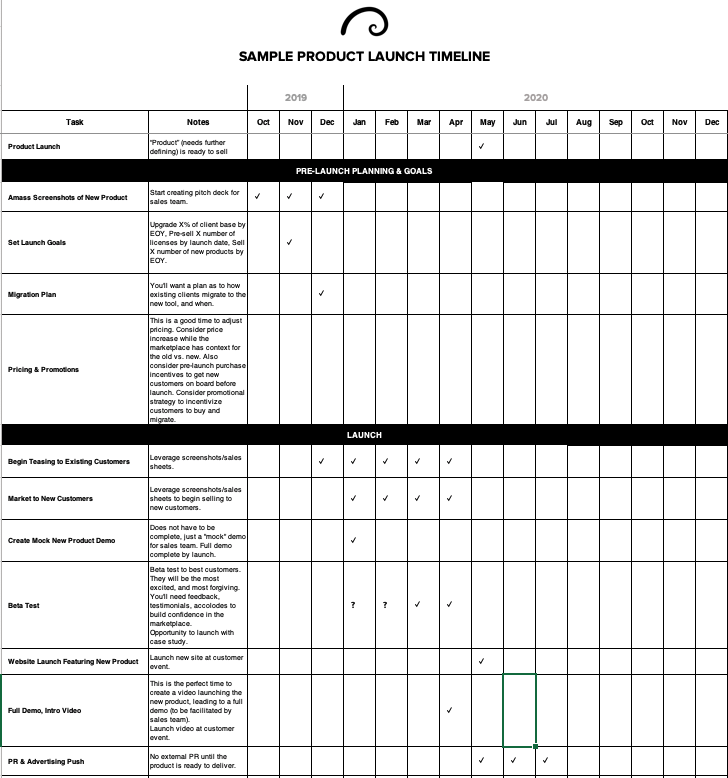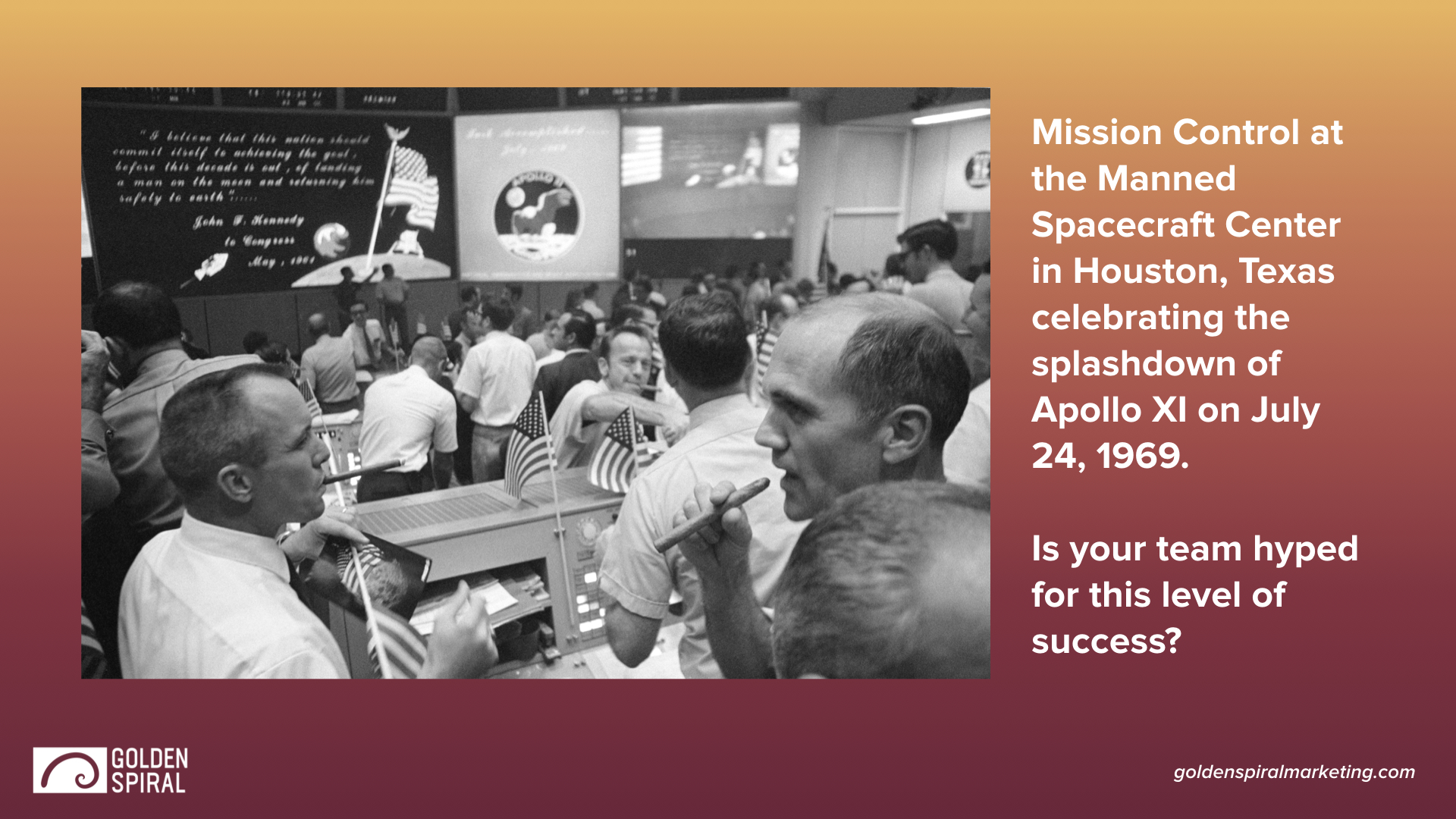The Complete Product Launch Guide for B2B Marketers

Walter Isaacson’s biography of Steve Jobs — along with the many other books, movies, or documentaries made about him — is a case study in failure and success, products launched too soon, and products that didn’t launch soon enough. In just about 120 minutes, the movie shows you Apple’s humble beginnings. You’ll discover what it takes to see into the future, identify a gap and fill it with something new and exciting, even when everyone tells you it’s a bad idea. Selling out products in a matter of minutes was once very, very far from the norm.
I bring Jobs’ and Apple’s history to your attention for both inspiration and a point of reference for product launches. Successful product launches, and product launch campaigns, don’t happen overnight. They demand time, planning, and articulate execution.
As a marketing agency that specializes in working with B2B SaaS and other tech companies to create and implement successful go-to-market strategies, Golden Spiral knows a thing or two about the art of a successful SaaS product launch — and it begins long before the product actually hits the market. Here is a proven, ten-step method for bringing your product to market.
A caution before we begin: your product launch will not live up to your expectations unless grounded in two things:
- You must fully understand your Buyer Matrix — who your buyer is, what motivates your buyer, and the real, career-challenging problem your buyer needs to solve.
- You must dedicate yourself to talking more often and more effectively about the problem(s) your product solves rather than just the cool tech it’s built upon.
1. Create a Timeline
 The first order of business: create a defined timeline. An effective product launch is typically scheduled around a specific date: a customer event, an anniversary (business or product), or a time of year coinciding with the buying cycle (e.g., back to school, new fiscal year, etc.)
The first order of business: create a defined timeline. An effective product launch is typically scheduled around a specific date: a customer event, an anniversary (business or product), or a time of year coinciding with the buying cycle (e.g., back to school, new fiscal year, etc.)
Your organization and product can’t be “ready” if there’s no documented timeline, milestones, and launch date. A timeline keeps your entire organization focused and accountable, and sets realistic expectations.
Don’t develop your timeline in a vacuum. Convene a cross-functional team with members from product, marketing, sales, customer service, and executive teams. There are more pieces to a product launch than one department can see. Work together to get all of the needed touch points out in the open and understood by all.
Keep your customer at the forefront of your mind. You will uncover hurdles and dead ends in your current processes that block the launch of your product. Identifying them now will give you time to overcome them before launch. Don’t let a procedural problem block you from the best launch possible.
Depending on how product development goes, however, you may have to slightly alter your timeline.
The most successful launches have healthy tension — like that of a guitar string — between the product launch date and the rollout of marketing materials. That tension can turn deadly, though, if you hype features that don’t make it into the final product or have to reschedule the launch. You don’t want to burn customer goodwill nor set yourself up for failure. (Look to this fine Coppola biopic as a cautionary tale.)
Create a master timeline. Every team — not just product development — needs their own timeline. Every department needs lead time to develop the best resources specific to their function.
No timeline is complete without a set of goals and the metrics to track them. Create them now, but recalibrate them closer to launch. (See step #7.)
2. Gather Feedback and Innovate
Prior to pouring resources into your product, you’ll want to make sure it’s viable.
More than likely, you’ve been listening to your customers for years and hearing about the problem your product seeks to solve. John Farkas, our CEO, has witnessed many SaaS companies go off the rails during product development because they begin to develop something for the sake of the technology. Just because the technology can perform in a certain way doesn’t mean it will sell.
Successful SaaS product launches flow out of feedback. Now is the time to gather more. Feedback can be gathered via surveys and/or one-on-one interviews. In either case, create a list of set questions to ask your current clients. Be sure to share the feedback with your cross-functional team.
- What have your clients said they wish your product could do?
- What is lacking from your industry?
- What will save your target audience time and money?
3. Beta Test with Current Clients
All of your research and hard work doesn’t mean anything until it’s in the hands of real customers who will push it, pull it, stretch it to its limits, ask questions you haven’t dreamed of, and discover new applications for it. They will break it. They will learn how to fix it.
 These tests are your litmus test of success. Let users inform and influence if you have a product ready for the marketplace.
These tests are your litmus test of success. Let users inform and influence if you have a product ready for the marketplace.
If you decide to beta test with existing customers, use your best ones. They have a relationship with you. They want to work with you and they want to be involved. It’s in their best interest. But it’s important to supplement this with new customer testing for real insight. Product and development teams need to closely align with this process — user testing is not relegated to marketing teams behind a mirror!
From your testing, listen carefully and gather all of the information you can. Your cross-functional team can learn so much from the test results:
- Engineering will learn the limits of the product — and where there is the most potential
- Marketing will hear stories and phrases that they can develop into materials
- Customer Service will discover what obstacles to overcome and how to respond
- The C-Suite will gain confidence and see the possibilities.
4. Go to Market with a Functioning Product
At launch, your product needs to strike a delicate balance between being a minimally viable product (MVP) that will require well-orchestrated iterations to get it up to full speed, and a fully-functioning, benefit-focused product that meets the needs of your users (at least most of them). A key step to achieving that balance is through your beta testing.
But what happens when your product isn’t ready for the market?
Do you move forward or recalibrate your timeline?
The fear is real.
A famous scene from the movie based on Walter Issacson’s biography of Jobs recounts the moments when a nervous Jobs was about to present on an under-developed product. The computer is supposed to say “hello,” when turned on. And it doesn’t. Sure, the feature doesn’t prevent the computer from actually functioning, but for Steve Jobs, that functionality was critical to the success of the launch. (Here is real footage of what happened in the moments following.)
How you move forward determines the success of the launch and the long-term success of the product.
There are two important sides to the functionality coin for a SaaS go-to-market scenario: either your new product is over-engineered and can’t be easily grasped and assimilated (a common scenario, especially in the world of B2B tech), or it’s under-engineered and you haven’t solved the basic problems of your users. In either scenario, you’re toast.
If the product isn’t everything you hoped it would be at launch but is still MVP, make sure everyone throughout the process knows the details so that the message remains clear and consistent. Don’t allow sales or marketing or an executive to tout a feature that’s not in version 1.0.
Likewise, if you make the decision to postpone the launch, communicate the reasons why throughout the organization so there is no bitterness or unrest. Keep the healthy tension on the schedule and move forward to your new launch date.
Note: the product will never be perfect. You can tweak and tweak for years to come. A launched product is always better than a product never launched. Be wise, but be bold.
5. Create a New Product Demo and a Sales Deck
Can you feel the excitement building? After developing an MVP and inviting others to kick its tires, it’s time to polish up your product and get it ready for the final phases of the launch.
Choose the proper demo type for your product.
- Would a video or photographic walkthrough be best?
- Should you create a sandbox version that allows your customers to put in real data and play around with it themselves?
- Could you create an experience that involves your salesperson and a potential customer?
We recently attended a product demo that allowed us to interact with the proprietary framework of the company from our cell phones. We were texted a link. When we clicked, we were taken on our phones to a one-time portal and asked to input information. After we hit send, we watched on the big screen in the conference room as our inputs ran through the software. We also looked back at our phones to see that the experience was over and couldn’t be replicated. It was effective and fascinating to take part.
No matter what demo you create, you will also need a sales deck. Consider creating a deck that aligns your marketing and sales teams. Allow marketing to create a deck that communicates the core messages and addresses the customer problems but allows sales to personalize or modify the deck based on the types of presentations needed.
In future articles, we will go into more depth about the many methods of building a product demo and the essential pieces you need.
6. Get Your Organization Hyped
Software Product launches are not solely the responsibility of your product, marketing team or sales team. The responsibility belongs to everyone, and your entire organization needs to be ready and aligned for a product launch. Building a cross-functional team at the beginning of the process makes this stage in the launch sequence much easier and much more effective.
 At this point, your messaging is locked in, your demo and sales deck are working well, all departments are buzzing like launch control before Apollo XI, and the finance department is losing hair, biting fingernails, or both.
At this point, your messaging is locked in, your demo and sales deck are working well, all departments are buzzing like launch control before Apollo XI, and the finance department is losing hair, biting fingernails, or both.
Host a handful of live internal trainings or webinars to introduce the product and answer important FAQs. You’ll also want to use this time to distribute collateral and documentation to each team so your message is consistent. We call this practice “internal communications alignment.”
7. Recalibrate Measurable KPIs
Look back to the goals and Key Performance Indicators (KPIs) you created at the beginning of the process? Are they still the right metrics to track success? Are there some to eliminate? Add? Change?
For a product launch, your KPIs might look something like this:
- Increase website traffic by 75% within three months of product launch
- Up-sell 30% of clients within three months of product launch
- Close 25 new deals within six months of product launches
- Maintain 90% client retention within one year of product launch
Your goals should be based on the success of previous product launch campaigns (if any), the need of the market, time of year, and available resources. The most important attribute of any goal is that it is actually achievable! The healthiest goals push every department but don’t break them. A goal set too aggressively tempts a department or individual to move the goal post instead of inspiring second effort.
Like product messaging, share and update these KPIs throughout the organization. After launch, let everyone see how the company is progressing toward success. Give moments to celebrate. Point to the game clock and scoreboard to inspire more grit.
8. Determine Pricing
A new SaaS product launch is the perfect time to evaluate your pricing.
A new product sets the tone for previous products. Should you raise prices across the board? Is the new product a premium and former products now slightly discounted?
If you updated — or overhauled — an existing product with attention to UX/UI, position it as more valuable than its predecessor.
 Capitalize on this while you can. You can also create sales incentives that allow buyers to purchase the new product at “old” product pricing for a limited amount of time before the price increases. Again, your goal is to create sales velocity, so there are several strategies you can explore to find which best suits your offering.
Capitalize on this while you can. You can also create sales incentives that allow buyers to purchase the new product at “old” product pricing for a limited amount of time before the price increases. Again, your goal is to create sales velocity, so there are several strategies you can explore to find which best suits your offering.
If your product and your market require a pricing page on your website, don’t neglect these concepts.
9. Create a Product Launch Plan
The objective of a product launch plan is simple: build momentum and sales velocity! A new product launch can be rocket fuel for your sales pipeline, both in renewals for existing customers and share-of-wallet for net-new business. When you construct a product launch campaign, you’ll want to consider two key launches: the existing customer launch and the prospective customer launch.
THE EXISTING CUSTOMER LAUNCH
For obvious reasons, you’ll want to sell to existing clients first. Arm yourself with a migration plan to eliminate fears and trepidation about this potentially disruptive process (depending on the complexity of your product). The true kickoff of your new product begins when you start marketing to current clients.
Prior to launch, you should have already considered how to keep the migration from old to new as cost effective and hassle-free as possible, as failure to do so may equal loss of existing customer base.
Additionally, you should have a KPI in place for how many customers you want to upgrade in a certain amount of time (upgrade X% of client base in next Y months). This should coincide with the sundown plan for your “old” product.
With this launch plan, your key objectives are to:
- Keep your existing customers with you (and potentially upgrade them)
- Reduce the attractiveness of alternatives from competitors
- Dislodge or disrupt the competition who are knocking on your customer’s door
THE PROSPECTIVE CUSTOMER LAUNCH
Your timing for selling to new clients is also important. Too early and you’ll lose momentum and excitement for when the product is actually available; the fuse will burn out before the firework launches. Too late and you may not reach the velocity you need leading into launch day; plus, you’ll miss out on the opportunity for pre-launch incentives that can help achieve sales goals.
A product launch campaign geared towards prospective customers gives you a new opportunity to speak to two important audiences:
- Cold or dead leads that know you, but decided to either not purchase your product, or go with a competitor
- New prospects that have never heard of you — until now!
Pay-per-click ads, content, email, collateral pieces all blitzed around a launch date will give you that momentum.
With this launch plan, your key objectives are to:
- Build greater brand awareness through marketing and PR efforts around launch time
- Increase the number of product demos and trials (if you have them) conducted by your sales team
- Increase in product sales to new clients
With this campaign, you will also want to set a measurable KPI, such as a number of new deals, inbound leads, or demos by a certain date. Your momentum is highest in the months right after launch date — so capitalize on it!
In either case, you’ll want to rely on a combination of marketing automation and one-on-one human interaction to make the process go smoothly.
10. Launch!
Maximize your product launch by choosing a specific, relevant date:
- company anniversary
- significant trade show
- user conference
Though their sales team has already been teasing the new product in the marketplace for several months, launch day makes it official: the product is ready to purchase, migration can start, the new website launches, and PR efforts begin.
Key Takeaway
If you want your product to be successful, you need to plan and implement a go-to-market strategy. It requires cross-company collaboration, planning, strategy, and focus! And, if you need help crafting the perfect launch plan and go-to-market strategy, we have a deep bench of SaaS marketing experts who can help you craft the perfect launch plan.